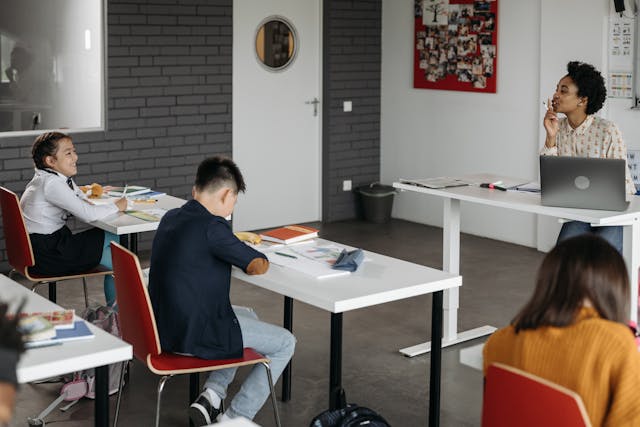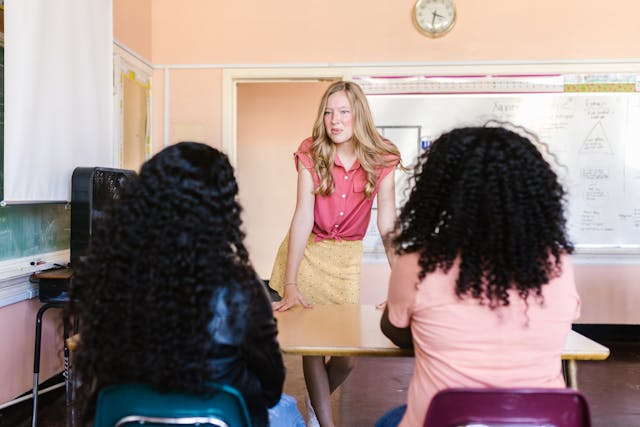Tier 3 interventions in MTSS: Strategies & examples

Supporting children in the classroom is one of the most crucial and demanding tasks schools face. Today’s students have increasingly complex needs that often demand more than the basic levels of support. A Multi-Tiered System of Supports (MTSS) is crucial for helping students achieve success. The Tier 3 level of intervention is the most intensive, individualized support you can offer students. MTSS Tier 3 interventions use structured, evidence-based strategies to address academic and behavioral challenges and social, emotional, and environmental needs.
Here, we’re sharing strategies and Tier 3 intervention examples you can use in the classroom, with tips that ensure you’re equipped to respond to every student’s needs. Read on to learn how to truly change the trajectory of lives and help every student succeed in school and in life.
How Tier 3 fits into the larger MTSS framework
The MTSS framework is a layered approach to addressing students’ needs in education. Think of it like a pyramid, where the bottom and widest layer is Tier 1. Here, all students receive the core and universal support you’d expect in a classroom environment. For some students, more is needed. There are many students who would benefit from the Tier 2 system, which builds on the first layer but offers more targeted help in small group settings. The top of the pyramid is the third tier. According to research, tier 3 support is required by an estimated 1–5% of students.
Support at the third tier builds on strong Tier 1 and Tier 2 systems. For strategies to be successful, solid lower tiers are a must. The upper tiers can’t function effectively without a strong foundation. If the base of the pyramid is shaky, the benefits of Tiers 2 and 3 will almost always fall short. For example, if a student moves into Tier 3 but hasn’t had their foundational reading gaps or behavioral needs addressed in Tiers 1 or 2, there’s little chance that Tier 3 support will be effective.
“If a student has signs that they are struggling behaviorally or emotionally and they are missed at earlier on it is more likely that they will enter into more of a crisis phase. A student may not be able to perform academically and may also be completely overwhelmed.”
- Laura Magnuson, MA, MS, LAMFT, VP of Clinical Engagement
How to identify when students need Tier 3 support
Tier 3 interventions require careful documentation and effort at the Tier 2 level. Most often, moving a student to Tier 3 is only an option when gaps remain even after Tier 2 interventions have been provided. Using clear, data-driven benchmarks is the best way to assess a student’s growth and needs.
For example, if a student receiving Tier 2 support spends several weeks with minimal or no progress in small-group intervention or persists in behavior challenges despite targeted plans, it may be time to consider moving them up to Tier 3.
There’s no universal timeline for MTSS, but weekly or bi-weekly check-ins and monitoring are essential for tracking growth and determining if interventions are working. If benchmarks aren’t met over time, and limited improvement is observed at the Tier 2 level, the conversation to advance the level of support will likely start.
"If a student is shutting down and withdrawing or acting out and having emotional outbursts this may indicate a need to escalate to tier 3."
- Laura Magnuson, MA, MS, LAMFT, VP of Clinical Engagement
Essential components of Tier 3 interventions
Tier 3 interventions can’t just be more of the same. They require data-driven approaches and can include several of the following strategies.
- Individualized and intensive: This approach is designed for one student at a time, and relies on flexible scheduling, increased instructional time, and frequent one-on-one support.
- Data-driven and diagnostic: Constant attention to assessment data is necessary. Tracking tools, such as academic performance data and behavioral charts, can help identify and respond to the root causes of a student’s struggles.
- Multidisciplinary team involvement: Every level of intervention requires a team approach. Educators, interventionists, counselors, behavioral specialists, administrators, and families are all critical parts of a care team. They must work together to provide leveled support across the tiers. At the Tier 3 level, it’s common for more meetings and consistent communication to occur.
- Integration of wraparound and community supports: The most effective Tier 3 plans coordinate with therapists, healthcare providers, and social service agencies. Additional resources ensure that outside stressors impacting the classroom environment can be adequately addressed.
- Formal plans and documentation: All interventions rely heavily on planning and documentation. It’s essential to track goals, strategies, how often one-on-one check-ins are, and what the exit criteria are. The work you do upfront to track and monitor plans ensures clarity and accountability.
- Frequent and continuous monitoring: Progress should be monitored daily, weekly, or as needed. Tracking ensures you can adjust immediately if a student isn’t progressing.
- Gets to the root of the issues: If a student’s anxiety manifests as behavior concerns in the classroom, interventions can address the root cause—in this case, the anxiety—rather than the behaviors the student exhibits.
- Highly trained staff members: Tier 3 support often requires advanced expertise. You may need to bring in specialists, consult with outside agencies, or utilize wraparound services to ensure students receive the comprehensive support they need.
- Collaborative approach with families and external providers: Collaboration is a critical part of Tier 2 and Tier 3 interventions. Working with families and other external providers will give you the best results. You’re not just sending home a daily or weekly note with updates. Actively involving caregivers and community partners helps with goal setting, progress monitoring, and evaluation.
Tier 3 academic intervention strategies
Tier 3 academic supports go further than Tier 2 strategies. While both levels involve frequency, individualization, and intensity, Tier 3 deepens the level of care at every touchpoint. Instead of small-group work, you might work one-on-one with a student to address foundational skill gaps.
You can use assistive technology here too, like:
- Text-to-speech software
- Speech-to-text software
- Alternative keyboards or input devices
- Audiobooks
- Audio recorders
- FM listening systems that amplify voices and minimize background noise
Design individualized learning plans using data
A student who cannot move forward or seems to be “stuck” despite multiple cycles of Tier 1 and 2 support may benefit from the additional layers Tier 3 can offer. You’ll be able to rely on various data sources to create a plan that identifies and addresses exactly where the learning breakdown is occurring. You might use:
- Universal screeners
- Diagnostic assessments
- Qualitative notes
- Observations
- Academic performance data
- Behavior incident reports and logs
- Attendance records
- Functional behavior assessments (FBAs)
- English language proficiency scores
- Student, family, and teacher or school staff surveys
Example: You analyze a student’s reading fluency, comprehension scores, and classroom participation and realize they need more targeted instruction on phonological awareness. You create a 1:1 plan for 3 sessions per week, with progress monitoring and scaffolded reading passages. Consistent reviews help you adjust the plan in real-time so the student continues to progress.
Deliver 1:1 explicit instruction with frequent check-ins
Most Tier 3 students need more personalized attention. One-on-one sessions that use explicit and systematic instruction generally offer the best results. They allow you to address persistent skill gaps, build student confidence, and develop trust. Try strategies like:
- Direct modeling
- Guided practice
- Frequent and immediate feedback
- Scaffolded instruction
- Increased practice
Example: You work with a student who’s struggling with multiplication for 20 minutes a day. You develop and use a hands-on, step-by-step approach and end each lesson with a quick assessment to track and gauge learning. For example, you might end sessions with something like a quick fist-to-five check-in.
Use precision teaching to track and adjust instructional pacing
Precision teaching isn’t about speed as much as it’s about targeted instruction. Identifying the specific skills that are lacking helps you adjust as new data becomes available.
Example: If a student exhibits handwriting speed but struggles with letter formation, it can affect reading progress. While focusing on formation, track their performance daily and graph growth each week. As the data demonstrates improvement, you can increase its ease of tracking.
Incorporate assistive technology for students with learning barriers
The abundance of technology available for educational use today can become a lifeline for Tier 3 learners. If traditional teaching methods aren’t working, educators can use tools like:
- Text-to-speech apps
- Interactive whiteboards
- Adaptive keyboards
- Speech recognition software
- Eye-tracking devices
- Screen readers
- Various educational apps
- Augmentative and alternative communication (AAC) devices
Example: A student who’s diagnosed with dyslexia can use audiobooks, a personalized reading app, and one-on-one coaching. You can track their comprehension level and engagement with the app’s analytics to ensure they’re improving.

Tier 3 behavioral intervention strategies
Academic support alone isn’t always enough. This is when Tier 3 behavioral interventions can be implemented to address behavioral/emotional needs and improve student mental health. If you recognize a student is struggling with emotional or behavioral patterns like anxiety, depression, social skills deficit, or trauma response, Tier 3 behavioral interventions might help.
These strategies will go much deeper than the universal social-emotional lessons broadly applied at the Tier 1 level.
Conduct functional behavior assessments (FBAs)
Functional behavior assessments (FBAs) should be used for students who exhibit disruptive behavior like classroom outbursts or leaving without permission. Instead of labeling students as defiant, Tier 3 plans use an FBA to create a structured process that’s specifically designed to identify and manage the student’s triggers.
Track data and patterns to identify the source of anxiety or depression. If assessments show that transitions are triggering a student’s anxiety, you can create interventions to help them learn to navigate changes. You might use things like:
- Visual schedules
- Peer-buddy systems
- Regular team check-ins
- Antecedent-Behavior-Consequence (ABC) tracking to record what happens before, during, and after an episode
- Structured environmental modifications, like changing seating charts
- Functional analysis screening tools (FAST)
Create individualized Behavior Intervention Plans (BIPs)
After figuring out the “why” of behavioral issues, you can create highly specific and readily actionable individualized plans.
After completing an FBA, a BIP may address high-stress activities. Maybe you offer gentle reminders, provide a quiet space to self-regulate, or use a reward system that encourages the use of healthy coping skills. Be sure to document, monitor, and adjust strategies and refine the process along the way.
Use person-centered planning for students with intensive emotional needs
When students have intense emotional needs that stem from anxiety, depression, or trauma, they might benefit from person-centered planning. This starts with:
- Using the student’s voice and input
- Involving them in goal setting
- Having them reflect on their strengths
- Teaching them to identify supports that feel safe and effective
You should always meet with the student and their family to develop a plan that works and makes sense to the student. This might include one-on-one therapy for students, daily check-ins, or outside mental health support. Person-centered plans can change and evolve quickly, so be sure to follow the student’s lead and respect their needs.
“Bringing the student into the conversation empowers them to make their own decisions instead of simply being told what they need to do. Using the students input will also allow successful problem solving in the future.”
- Laura Magnuson, MA, MS, LAMFT, VP of Clinical Engagement
Implement wraparound services with community agency coordination
Some students have complex needs that will benefit from wraparound services. For example, if a student is dealing with housing instability or food insecurity, they likely need more support than what the school can provide. Tier 3 support ensures you can get help beyond the school walls. You could use social workers, therapists, and other community support.
Get family consent for regular meetings with school members, mental health providers, and local youth program representatives. Every stakeholder should use the meetings to share updates and align support. This is also an effective way to track progress. Using wraparound services takes a holistic approach to care, ensuring students receive the support and advocacy they need.
Setting SMART goals and exit criteria in tier 3 plans
Setting clear, achievable goals is critical to the success of any Tier 3 intervention. SMART goals—Specific, Measurable, Achievable, Relevant, and Time-bound—help teams stay focused, aligned, and accountable. Instead of broad objectives like “improve reading,” a SMART goal might be: “Increase reading fluency from 60 to 90 words per minute in six weeks through three weekly 1:1 sessions.” These goals should be rooted in data and tailored to each student’s unique needs.
Alongside goals, it’s just as important to define exit criteria. What progress will indicate a student is ready to step down to Tier 2? What benchmarks signal success? Exit planning helps ensure that interventions are purposeful—not indefinite. It also reinforces student confidence and motivates teams to work toward meaningful, visible progress. With clear criteria in place, Tier 3 becomes not just a support system, but a structured path forward.
5‑Step implementation plan for tier 3 MTSS
For busy teachers, adding one more thing to your plate can feel daunting. With the evidence-based steps outlined here, your approach to Tier 3 support can be both impactful and sustainable.
- Build a multidisciplinary team with defined roles: You can’t do it all on your own. Teams made up of teachers, specialists, counselors, administrators, and families can share responsibilities and be more effective. Ensure that every role is defined in the beginning to prevent duplicated efforts and make sure nothing is overlooked.
- Use data to guide all decisions: It’s critical to collect, review, and act on data in a timely manner. You should review academic progress, behavior logs, attendance records, and feedback from the family and the student. Using data prevents minor issues from completely derailing your Tier 3 plan.
- Develop clear and specific plans: Clarify all goals and action steps. Identify staff assignments and check-in frequency. Create and use standardized templates across the building so everybody isn’t starting from scratch each time.
- Establish progress meetings: Hold weekly team meetings to review data and adjust interventions as needed. Remember to celebrate small wins to keep momentum. Progress meetings also ensure accountability.
- Openly coordinate and cooperate with families and external partners: Communication needs to be a two-way street when dealing with Tier 3 plans for students. Invite family members to all meetings and consider bringing community partners as needed. Housing agencies, additional outside mental health providers, and others can offer beneficial support and input.
Addressing common challenges when implementing tier 3 interventions
Even the best Tier 3 plans can run into roadblocks. Here’s how to navigate some of the most common implementation challenges:
- Limited staffing capacity: When staff is stretched thin, it can be tough to provide the intensive support Tier 3 students need. One solution is cross-training team members so they can cover check-ins or deliver specialized instruction when needed. Creative scheduling can also help distribute responsibilities without overloading any one person.
- Scheduling conflicts: Coordinating pull-out support and team meetings without disrupting core instruction is tricky. School-wide calendars, flexible instructional blocks, and real-time documentation tools can reduce friction. Rotating Tier 3 sessions ensures equitable access for all students over time.
- Data collection overload: Without a system in place, the volume of data required can feel unmanageable. To make it easier, use digital tools and standardized forms that streamline documentation across students. Assign clear data responsibilities to individual team members so nothing slips through the cracks.
- Lack of family buy-in: Families may be hesitant to engage in Tier 3 plans—especially if prior interventions haven’t worked. Building trust takes empathy and consistency. Offer virtual meeting options to increase accessibility, and make it a habit to celebrate even small wins so families can see that progress is possible.
Why early intervention prevents the need for Tier 3
Tier 3 support is not a punishment or a last resort. It’s a testament to how much schools, teams, and districts care about every student. When Tier 1 and 2 supports are well-organized and robust, and when social-emotional learning (SEL) is part of the plan, fewer students ultimately require Tier 3 support.
Proactive approaches like SEL, regular check-ins, and small group learning can help students build emotional regulation and resilience. Above all, remember that you’re not alone when addressing students’ needs. You have both the power and the tools to give students every opportunity for support.
If you want to learn more about how evidence-based digital mental health support can enhance MTSS Tier 3 interventions at your school, request a demo from Talkspace today.
Sources:
- Nitz, Jannik, Fabienne Brack, Sophia Hertel, Johanna Krull, Helen Stephan, Thomas Hennemann, and Charlotte Hanisch. 2023. “Multi-tiered Systems of Support With Focus on Behavioral Modification in Elementary Schools: A Systematic Review.” Heliyon 9 (6): e17506. https://doi.org/10.1016/j.heliyon.2023.e17506. Accessed July 21, 2025.






